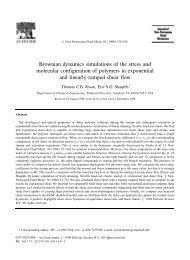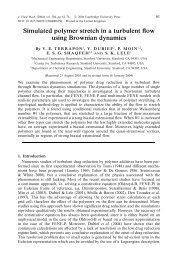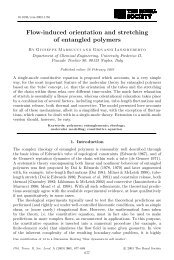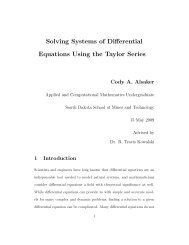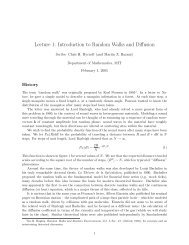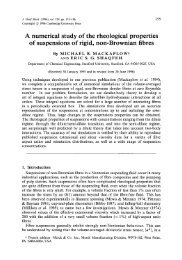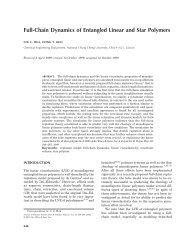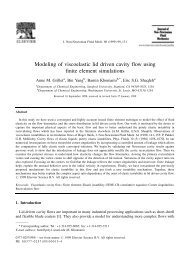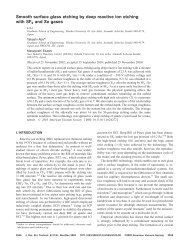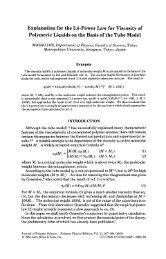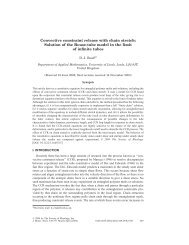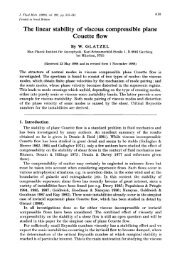Molecular modelling of entangled polymer fluids under flow The ...
Molecular modelling of entangled polymer fluids under flow The ...
Molecular modelling of entangled polymer fluids under flow The ...
Create successful ePaper yourself
Turn your PDF publications into a flip-book with our unique Google optimized e-Paper software.
52 CHAPTER 3. THE POM-POM MODEL IN EXPONENTIAL SHEAR.<br />
S xy<br />
0.25<br />
0.2<br />
0.15<br />
τ b<br />
[sec]<br />
3<br />
1<br />
0.3<br />
0.1<br />
0.03<br />
0.01<br />
0.1<br />
0.05<br />
0<br />
0 2 4 6 8<br />
time [sec]<br />
Figure 3.2: Evolution <strong>of</strong> S xy for nearly exponential shear with varying τ b values. α =<br />
1sec −1 .<br />
the orientation behaves essentially as for an affine deformation since the exponentially<br />
growing shear rate rapidly becomes very large compared to τ b . In this limit S xy is very<br />
well approximated by the affine orientation solution<br />
S xy (t) =<br />
e α t − 1<br />
4 + e 2 α t − 2 e α t . (3.5)<br />
This expression is obtained by taking the τ b → ∞ limit <strong>of</strong> equation 3.4 or by solving<br />
the orientation equation with the relaxation terms removed.<br />
In the opposite limit where 1/τ b ≫ α the expression for S xy can be simplified to<br />
S xy (t) =<br />
ατ b e αt<br />
2α 2 τ 2 b e2αt + 3 . (3.6)<br />
In this limit the initial shear rate is too small to produce any appreciable orientation.<br />
<strong>The</strong> backbone section must “wait” until the instantaneous shear rate is comparable to<br />
the reciprocal <strong>of</strong> its orientation time. Eventually the shear rate will become sufficiently<br />
large to orientate the backbone section and so S xy grows, peaks and then tends to zero<br />
at long times. In this limit the solutions for different values <strong>of</strong> τ b and α are related by<br />
S xy<br />
( t<br />
α 1<br />
, τ b1 , α 1<br />
)<br />
= S xy<br />
( t + ∆t<br />
α 2<br />
, τ b2 , α 2<br />
)<br />
where ∆t is a time shift factor given by<br />
∀t. (3.7)<br />
( )<br />
τb1 α 1<br />
∆t = ln . (3.8)<br />
τ b2 α 2



